Bert Hobmayer Univ. Prof. Dr. rer. nat. (Stellvertretender Institutsleiter)
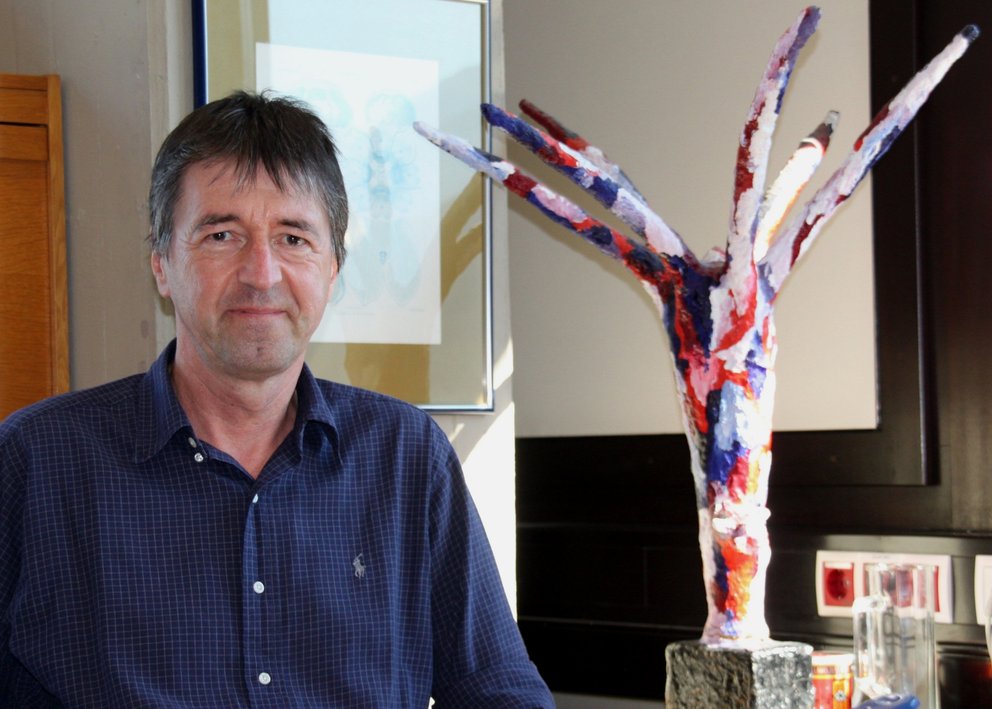
Institut für Zoologie
Universität Innsbruck
Technikerstr. 25
6020 Innsbruck
Österreich
Head of the research unit Evolutionary Developmental Biology
Deputy head of the Institute of Zoology and the Center of Molecular Biosciences Innsbruck (CMBI)
Member of the EU-COFUND PhD training program Ageing, Regeneration and Drug Research (ARDRE)
Member of the EU-COST research network Marine Invertebrate Stem Cells (MARISTEM) – from Basic Research to Innovative Applications
Current Research
The Hobmayer lab studies stem cells, regeneration and pattern formation in the immortal Hydra and the evolution of these phenomena
Adult stem cells are present in all organs of multicellular animals including humans, and they are the key players mediating replacement of damaged cells and regeneration. Moreover, ageing is clearly associated with declining stem cell pools. In order to gain understanding of the mechanisms that underlie these phenomena, we study the small freshwater polyp Hydra, a simple but powerful model organism for stem cell and regeneration biology.
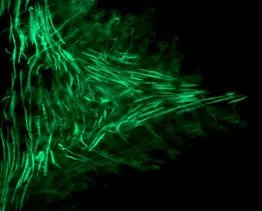
Hydra polyps are composed of about ten different cell types organized in two epithelial layers and exhibit one of the most simple and ancestral nervous systems. They exhibit astonishing properties as compared to other animals. They have an almost unlimited capacity for regeneration. Even after dissociation into single cell suspensions, polyps can re-aggregate and completely self-organize within days. Large stem cell pools building the polyp’s body continuously divide and replace all tissues within weeks. Despite this enormous cellular dynamics, somatic tumors never occur. In addition, Hydra seem to be virtually immortal. Under conditions of normal asexual growth, cellular and molecular mechanisms of ageing seem to be inactivated.
An extremely well annotated genome sequence revealed that the genetic toolkit of Hydra polyps is unexpectedly similar to that of higher animals and vertebrates. Thus, there is a clear chance to uncover basic principles of molecular regulation in a simple system, which are transferrable to the more complex animal model systems and humans. The work in my research group focuses on Wnt signaling networks and Myc stem cell maintenance factors.
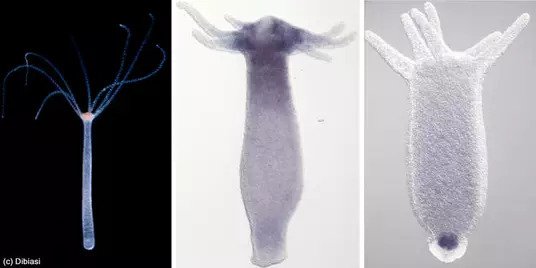
For more details see:
Stem cells, regeneration, axial patterning
Publications
Edited Book
- Ballarin, L., Rinkevich, B., and Hobmayer, B. (2022) Advances in Aquatic Invertebrate Stem Cell Research. MDPI Books, Basel
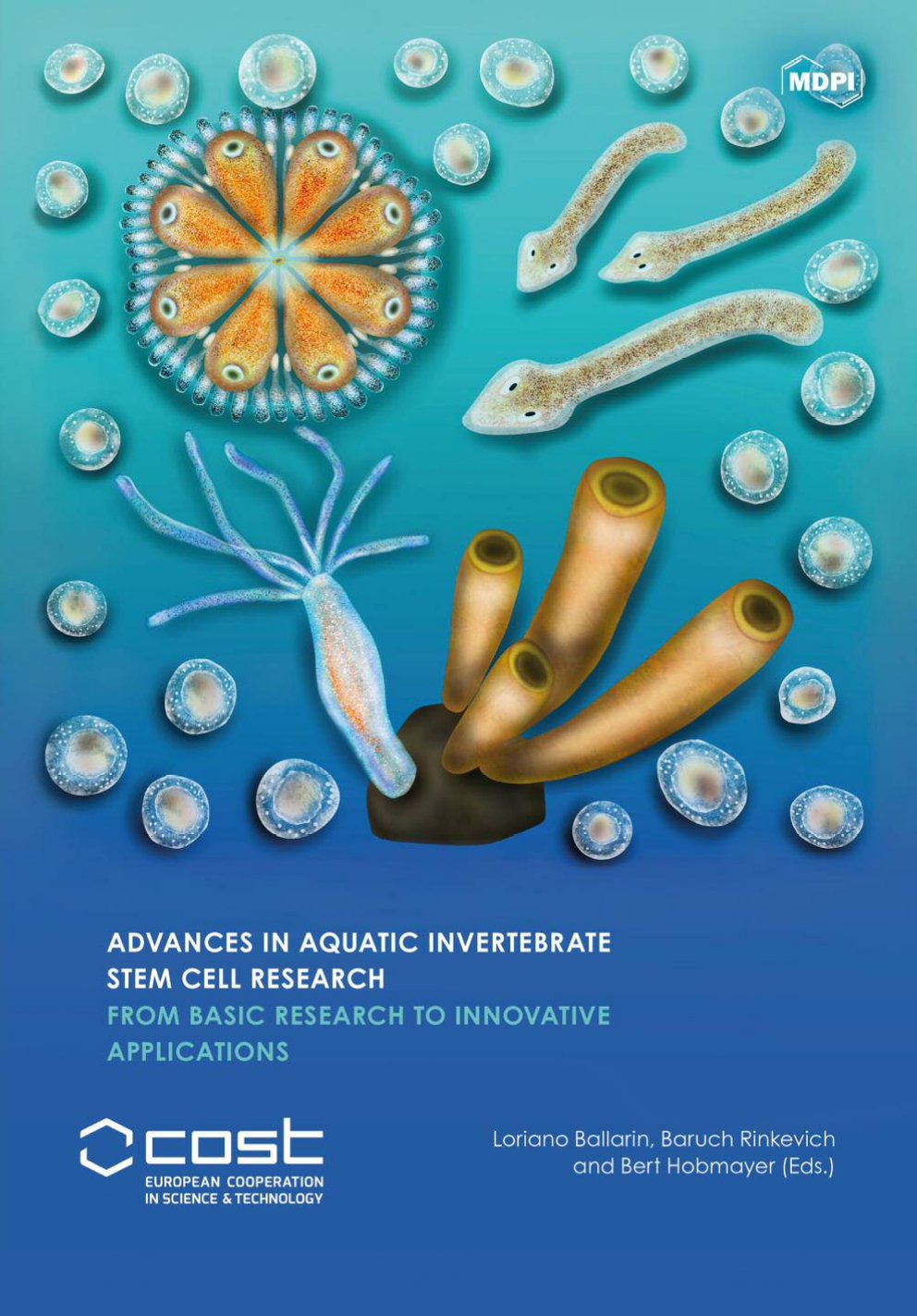
Free Pdf download:
https://www.mdpi.com/books/edition/5071
Scientific Papers
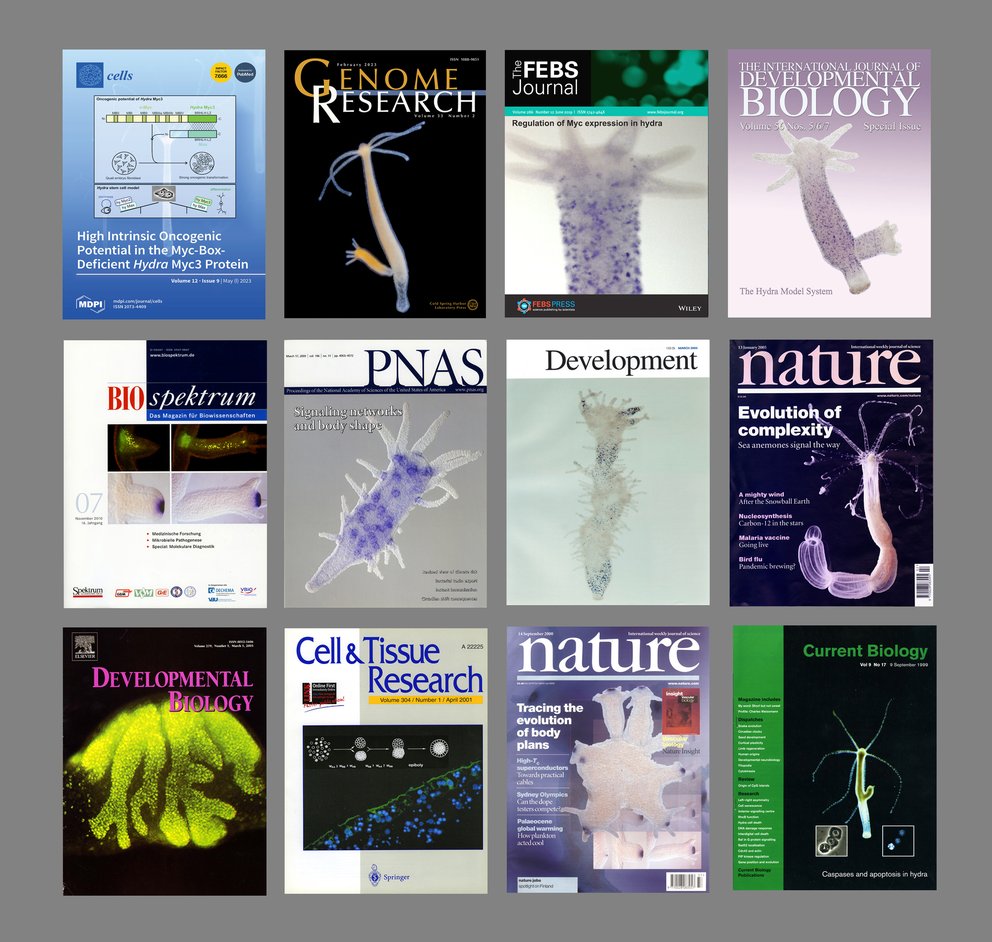
- Skokan, T.D., Hobmayer, B., McKinley, K.L., and Vale, R.D. (2024) Mechanical stretch regulates macropinocytosis in Hydra vulgaris. Mol. Biol. Cell (in press; bioRxiv: https://doi.org/10.1101/2021.12.03.471193)
- Keramidiotou, A., Schneid, S., Busse, C., Cramer von Laue, C., Bertulat, B., Salvenmoser, W., Heß, M., Alexandrova, O., Glauber, K., Steele, R., Hobmayer, B., Holstein, T., and David, C.N. (2024) A new look at the architecture and dynamics of the Hydra nerve net. eLife (in press, https://doi.org/10.7554/elife.87330)
- Lechable, M., Tang, X., Siebert, S., Feldbacher, A., Fernández-Quintero, M.L., Breuker, K., Juliano, C.E., Liedl, K., Hobmayer, B., and Hartl, M. (2023) High intrinsic oncogenic potential in the Myc-box-deficient Hydra Myc3 protein. Cells 12, 1265. (cover story)
- Cazet, J.F., Siebert, S., Little, H.M., Bertemes, P., Primack, A.S., Ladurner, P., Achrainer, M., Fredriksen, M.T., Moreland, R.T., Singh, S., Zhang, S., Wolfsberg, T.G., Schnitzler, C.E., Baxevanis, A.D., Simakov, O., Hobmayer, B., and Juliano, C.E. (2023) A chromosome-scale epigenetic map of the Hydra genome reveals conserved regulators of cell state. Genome Research 33, 283-298. (cover story)
- Seabra, S., Zenleser, T., Grosbusch, A., Hobmayer, B., and Lengerer, B. (2022) The involvement of cell type-specific glycans in Hydra temporary adhesion revealed by a lectin screen. Biomimetics 7, 166.
- Brooun, M., Salvenmoser, W., Dana, C., Sudol, M., Steele, R., Hobmayer, B., and McNeill, H. (2022) An ancient role for the Hippo pathway in axis formation and morphogenesis. PNAS 119, e2203257119.
- Rinkevich, B., Hobmayer, B., Rosner, A., and Ballarin, L. (2022) Somatic expression of stemness genes in aquatic invertebrates. In Advances in Aquatic Invertebrate Stem Cell Research. (Ballarin, L., Rinkevich, B., Hobmayer, B., Eds.), pp. 95-171. MDPI Books, Basel.
- Lechable, M., Achrainer, M., Kruus, M., Salvenmoser, W., and Hobmayer, B. (2022) Molecular regulation of decision making in the interstitial stem cell lineage of Hydra revisited. In Advances in Aquatic Invertebrate Stem Cell Research. (Ballarin, L., Rinkevich, B., Hobmayer, B., Eds.), pp. 201-220. MDPI Books, Basel.
- Martinez, P., Ballarin, L., Ereskovsky, A.V., Gazave, E., Hobmayer, B., Manni, L., Rottinger, E., Sprecher, S.G., Tiozzo, S., Varela-Coelho, A., and Rinkevich, B. (2022) Articulating the “stem cell niche” paradigm through the lens of non-model aquatic invertebrates. BMC Biology 20, 23.
- Rinkevich, B., Ballarin, L., Martinez, P., Somorjai, I., Ben-Hamo, O., Borisenko, I., Berezikov, E., Ereskovsky, A.V., Gazave, E., Khnykin, D., Manni, L., Petukhova, O., Rosner, A., Röttinger, E., Spagnuolo, A., Sugni, M., Tiozzo, S., and Hobmayer, B. (2022) A pan-metazoan concept for adult stem cells: the wobbling Penrose landscape. Biol. Reviews 97, 299-325.
- Hartl, M., Glasauer, S., Gufler, S., Raffeiner, A., Puglisi, K., Breuker, K., Bister, K., and Hobmayer, B. (2019) Differential regulation of myc homologs by Wnt/b-Catenin signaling in the early metazoan Hydra. FEBS J. 286, 2295-2310. (Cover story)
- Ballarin, L., Rinkevich, B., Bartscherer, K., Burzynski, A., Cambier, S., Cammarata, M., Domart-Coulon, I., Drobne, D., Encinas, J., Frank, U., Geneviere, A.-M., Hobmayer, B., Löhelaid, H., Lyons, D., Martinez, P., Oliveri, P., Peric, L., Piraino, S., Ramšak, A., Rakers, S., Rentzsch, F., Rosner, A., da Silva, T.H., Somorjai, I., Suleiman, S., and Coelho, A.V. (2018) MARISTEM - Stem cells of marine/aquatic invertebrates: from basic research to innovative applications. Sustainability 10, 526.
- Gufler, S., Artes, B., Bielen, H., Krainer, I., Eder, M.-K., Falschlunger, J., Bollmann, A., Ostermann, T., Valovka, T., Hartl, M., Bister, K., Technau, U., and Hobmayer, B. (2018) b-Catenin acts in a position-independent regeneration response in the simple eumetazoan Hydra. Dev. Biol. 433, 310-323.
- Aufschnaiter, R., Wedlich-Söldner, R., Zhang, X., and Hobmayer, B. (2017) Apical and basal epitheliomuscular F-actin dynamics during Hydra bud evagination. Biol. Open 6, 1137-1148.
- Rodrigues, M., Beisel, C., Berezikov, E., Hobmayer, B., and Ladurner, P. (2016) Profiling of adhesive-related genes in the freshwater cnidarianHydra by transcriptomics and proteomics. Biofouling 32, 1115-1129.
- Rodrigues, M., Leclère, P., Flammang, P., Hess, M., Salvenmoser, W., Hobmayer, B., and Ladurner, P. (2016) The cellular basis of bioadhesion of the freshwater polyp Hydra. BMC Zoology 1, 3.
- Seybold, A., Salvenmoser, W., and Hobmayer, B. (2016) Sequential development of apical-basal and planar polarity in aggregating epitheliomuscular cells in Hydra. Dev. Biol. 412, 148-159.
- Juliano, C. and Hobmayer, B. (2016) Animal evolution: new perspectives from early emerging metazoans. Meeting report. BioEssays 38, 216-219.
- Hasse, C., Holz, O., Lange, E., Pisowodzki, L., Rebscher, N., Eder, M.-K., Hobmayer, B., and Hassel, M. (2014) FGFR-ERK signaling is an essential component of tissue separation in Hydra. Dev. Biol. 395, 154-166.
- Bosch, T., Adamska, M., Augustin R., Domazet-Loso, T., Foret, S., Fraune, S., Funayama, N., Grasis, J., Hamada, M., Hatta, M., Hobmayer, B., Kawai, K., Klimovich, A., Manuel, M., Shinzato, C., Technau, U., Yum, S., and Miller, D.J. (2014) How do environmental factors influence life cycles and development? An experimental framework for early-diverging metazoans. BioEssays 36, 1185-1194.
- Hartl, M., Glasauer, S., Valovka, T., Breuker, K., Hobmayer, B., and Bister, K. (2014) Hydra myc2, a unique pre-bilaterian member of the the myc family, is activated in cell proliferation and gametogenesis. Biol. Open 3, 397-407.
- Marchesano, V., Hernandez, Y., Salvenmoser, W., Ambrosone, A., Tino, A., Hobmayer, B., De La Fuente, J. and Tortiglione, C. (2013) Imaging inwards and outwards trafficking of gold nanoparticles in whole animals. ACS Nano 7, 2431-2442.
- Hobmayer, B. and Rieger, R. (2013) Metazoa, tierische Vielzeller. In Spezielle Zoologie. Teil 1: Einzeller und wirbellose Tiere. 3. Auflage (Westheide, W. and Rieger, G., Eds.), pp. 59-77, Elsevier, München.
- Hobmayer, B. and Nickel, M. (2013) Parazoa. In Spezielle Zoologie. Teil 1: Einzeller und wirbellose Tiere. 3. Auflage (Westheide, W. and Rieger, G., Eds.), pp. 78-79, Elsevier, München.
- Hobmayer, B. and Rieger, R. (2013) Eumetazoa. In Spezielle Zoologie. Teil 1: Einzeller und wirbellose Tiere. 3. Auflage (Westheide, W. and Rieger, G., Eds.), pp. 108-116, Elsevier, München.
- Rieger, R., Haszprunar, G., Hobmayer, B. (2013) Bilateria. In Spezielle Zoologie. Teil 1: Einzeller und wirbellose Tiere. 3. Auflage (Westheide, W. and Rieger, G., Eds.), pp. 164-179, Elsevier, München.
- Hobmayer, B., Jenewein, M., Eder, D., Eder, M.-K., Glasauer, S., Gufler, S., Hartl, M., and Salvenmoser, W. (2012) Stemness in Hydra - a current perspective. Int. J. Dev. Biol. 56, 509-517. (Cover story)
- Ambrosone, A., Marchesano, V., Tino, A., Hobmayer, B., and Tortiglione, C. (2012) Hymyc downregulation through small interfering RNA promotes stem cell proliferation in Hydra vulgaris. PLoS ONE 7, e30660.
- Hobmayer, B., Philipp, I., Aufschnaiter, R., Eder, M.-K., Jenewein, M. (2010) Wnts in der Achsenbildung und Morphogenese bei Hydra. BIOspektrum 7/2010, 746-748. (Cover story)
- Chapman, J.A. et al. (2010) The dynamic genome of Hydra. Nature 464, 592-596.
- Hartl, M., Mitterstiller, A.-M., Valovka, T., Breuker, K., Hobmayer, B., and Bister, K. (2010) Stem cell-specific activation of an ancestral myc protooncogene with conserved basic functions in the early metazoan Hydra. PNAS 107, 4051-4056.
- Egger, B. et al. (2009) To be or not to be a flatworm: The acoel controversy. PLoS ONE 4, e5502.
- Philipp, I., Aufschnaiter, R., Özbek, S., Pontasch, S., Jenewein, M., Watanabe, H., Rentzsch, F., Holstein, T.W., and Hobmayer, B. (2009) Wnt/b-Catenin and noncanonical Wnt signalling interact in tissue evagination in the simple eumetazoan Hydra. PNAS 106, 4290-4295. (Cover story)
- Bode, H., Lengfeld, T., Hobmayer, B., and Holstein, T.W. (2008) Detection of expression patterns in hydra pattern formation. Methods Mol. Biol. 469, 69-84.
- Özbek, S., Adamczyk, P., Meier, S., Gross, T., Hobmayer, B., Grzesiek, S., Bächinger, H.P., and Holstein, T.W. (2008) Minicollagen-15, a novel minicollagen isolated from Hydra, forms tubule structures in nematocysts. J. Mol. Biol. 376, 1008-1020.
- Rentzsch, F., Guder, C., Vocke, D., Hobmayer, B., and Holstein, T.W. (2007) An ancient chordin-like gene in organizer formation of Hydra. PNAS 104, 3249-3254.
- Ladurner, P., Meyer, E., and Hobmayer, B. (2007) Reinhard Rieger. DZG Mitteilungen 2007, 59-63.
- Guder, C., Philipp, I., Lengfeld, T., Watanabe, H., Hobmayer, B., and Holstein, T.W. (2006) The Wnt code: cnidarians signal the way. Oncogene 25, 7450-7460.
- Guder, C., Pinho, S., Nacak, T., Hobmayer, B., Niehrs, C., and Holstein, T.W. (2006) An ancient Wnt-Dickkopf antagonism in Hydra. Development 133, 901-911. (Cover story)
- Hobmayer, B. (2006) Evolutionsbiologie (by U. Kutschera). Ber. nat.-med. Verein Innsbruck 93, 259-260.
- Philipp, I., Holstein, T.W., and Hobmayer, B. (2005) HvJNK, a Hydra member of the c-Jun NH2-terminal kinase gene family, is expressed during nematocyte differentiation. Gene Expr. Patterns 5, 397-402.
- Rieger, R.M., Ladurner, P., and Hobmayer, B. (2005) A clue to the origin of the Bilateria? Science 307, 353-354.
- Rentzsch, F., Hobmayer, B., and Holstein, T.W. (2005) Glycogen synthase kinase 3 has a pro-apoptotic function in Hydra oogenesis. Dev. Biol. 278, 1-12. (Cover story)
- Kusserow, A., Pang, K., Sturm, C., Hrouda, M., Lentfer, J., Schmidt, H.A., Technau, U., von Haeseler, A., Hobmayer, B., Martindale, M., and Holstein, T.W. (2005) Unexpected complexity of the Wnt gene family in a sea anemone. Nature 433, 156-160. (Cover story )
- Hobmayer, B., Rentzsch, F., Technau, U., and Holstein, T.W. (2004) Signaling molecules in the Hydra head organizer and the evolution of axis formation. Grav. Space Biol. Bull. 17, 107-113.
- Technau, U.,Hobmayer, B., Rentzsch, F., and Holstein, T.W. (2004) The small freshwater polyp Hydra as a model for axis formation in higher organisms. In Function and Regulation of Cellular Systems (Deutsch, A., Howard, J., Falcke, M., Zimmermann, W., Eds.), pp. Springer, Heidelberg, New York.
- Technau, U.,Hobmayer, B., Rentzsch, F., and Holstein, T.W. (2003) De novo formation of the Hydra head organizer. Nova Acta Leop. 332, 353-366.
- Holstein, T.W., Hobmayer, B., and Technau, U. (2003) Cnidarians – an evolutionary conserved model system for regeneration? Dev. Dyn. 226, 257-267.
- Hobmayer, B., Rentzsch, F., and Holstein, T.W.(2001) Identification and expression of HySmad1, a member of the R-Smad gene family of TGFb signal transducers, in the diploblastic metazoan Hydra. Dev. Genes Evol. 211, 597-602.
- Hobmayer, B., Snyder, P., Alt, D., Happel, C.M., and Holstein, T.W. (2001) Quantitative analysis of epithelial cell aggregation in the diploblastic metazoan Hydra reveals a switch from homotypic to heterotypic interactions. Cell Tissue Res. 304, 147-157. ( Cover story)
- Hobmayer, B., Rentzsch, F., Kuhn, K., Happel, C.M., Laue, C., Snyder, P., Rothbächer, U., and Holstein, T.W.(2000) Wnt signaling molecules act in axis formation in the diploblastic metazoan Hydra. Nature 407, 186-189. ( Cover story)
- Technau, U., Laue, C., Rentzsch, F., Luft, S., Hobmayer, B., Bode, H.R., and Holstein, T.W. (2000) Parameters of self-organization in Hydra aggregates. PNAS 97, 12127-12131.
- Cikala, M., Wilm, B., Hobmayer, E., Böttger, A., and David, C.N. (1999) Identification of caspases and apoptosis in the simple metazoan Hydra. Curr. Biol. 9, 959-962. (Cover story)
- Hobmayer, B., Holstein, T.W., and David, C.N. (1997) Stimulation of tentacle and bud formation by the neuropeptide Head Activator in Hydra magnipapillata . Dev. Biol. 183, 1-8.
- Hobmayer, E., Hatta, M., Fischer, R., Fujisawa, T., Holstein, T.W., and Sugiyama, T. (1996) Identification of a Hydra homologue of the b-catenin/plakoglobin/armadillo gene family. Gene 172, 155-159.
- Holstein, T.W. andHobmayer, E. (1996) Die Evolution entwicklungsbiologischer Prozesse. Forschung Frankfurt3/1996, 22-36.
- Holstein, T.W., Hobmayer, E., and David, C.N. (1991) Pattern of epithelial cell cycling in Hydra. Dev. Biol. 148, 602-611.
- Hobmayer, E.and David, C.N.(1990) Differentiation of a nerve cell-battery cell complex in Hydra. In Evolution of the First Nervous Systems (Anderson, P., Ed.), pp. 71-80. Plenum Press, New York.
- Hobmayer, E., Holstein, T.W., and David, C.N. (1990) Tentacle morphogenesis in Hydra. I. The role of head activator. Development 109, 887-895.
- Hobmayer, E., Holstein, T.W., and David, C.N. (1990) Tentacle morphogenesis in Hydra. II. Formation of a complex between a sensory nerve cell and a battery cell. Development 109, 897-904.
- David, C.N., Bosch, T.C.G., Hobmayer, E., Holstein, T.W., and Schmidt, T. (1987) Interstitial stem cells in Hydra. In Genetic Regulation of Development (Loomis, W.F., Ed.), pp. 389-408. Alan R. Liss Inc., New York.
